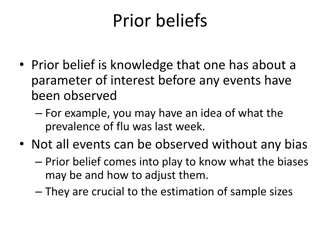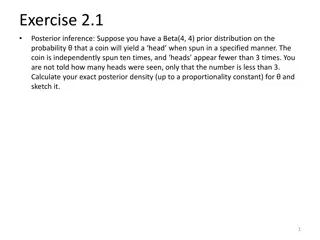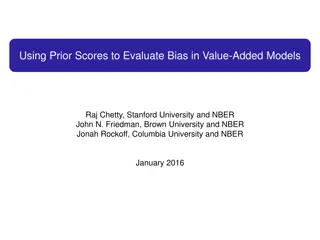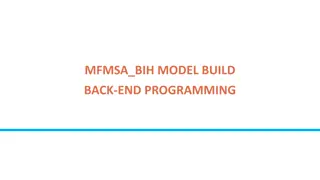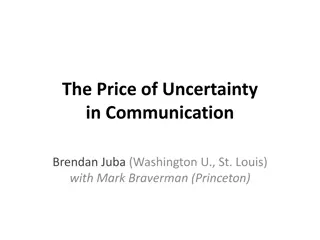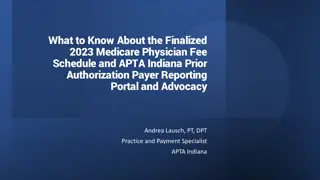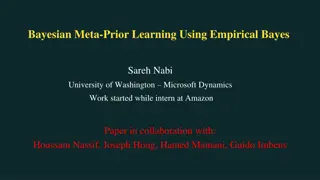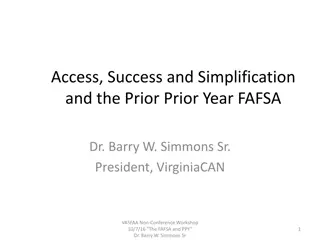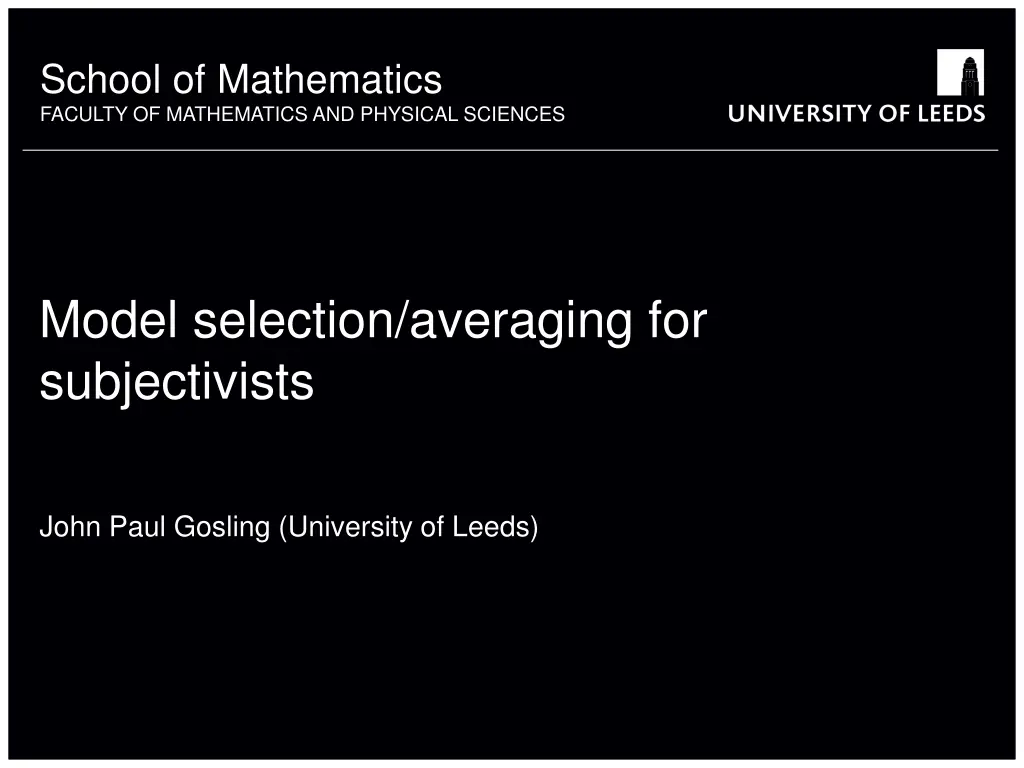
Model Selection and Averaging for Subjectivists in Mathematics and Physical Sciences
Explore the process of selecting prior probabilities for models in a complex dataset, using Bayesian methods and noninformative priors. Follow along a journey of analysis and decision-making to solve a big data problem successfully.
Download Presentation

Please find below an Image/Link to download the presentation.
The content on the website is provided AS IS for your information and personal use only. It may not be sold, licensed, or shared on other websites without obtaining consent from the author. If you encounter any issues during the download, it is possible that the publisher has removed the file from their server.
You are allowed to download the files provided on this website for personal or commercial use, subject to the condition that they are used lawfully. All files are the property of their respective owners.
The content on the website is provided AS IS for your information and personal use only. It may not be sold, licensed, or shared on other websites without obtaining consent from the author.
E N D
Presentation Transcript
School of something FACULTY OF OTHER FACULTY OF MATHEMATICS AND PHYSICAL SCIENCES School of Mathematics Model selection/averaging for subjectivists John Paul Gosling (University of Leeds)
Overview 1. Setting the scene 2. Model priors 3. Parameter priors 4. Plea for help Throughout. A number of dead ends
A typical Friday afternoon There is this really complicated dataset. We have spent millions collecting the data and hours talking to experts. 3/152
A typical Friday afternoon Our experts tell us that there are several plausible models. We will denote these: Each model has some parameter set denoted: with some parameters being shared across sets. 4/152
A typical Friday afternoon Obviously, Bayesian methods can be used here: Posterior Prior x Likelihood. We have lots of data so we will use noninformative priors for our model parameters. We use Bayes factors to find posterior odds for the plausible models. 5/152
A typical Friday afternoon 150/152
A typical Friday afternoon Clearly, model 1 is favoured. 151/152
A typical Friday afternoon Conclusions Solved a big data problem. MCMC is brilliant. Model 1 is best. THANK YOU FOR YOUR ATTENTION. THANK YOU FOR YOUR ATTENTION. ANY QUESTIONS? ANY QUESTIONS? 152/152
A typical Friday afternoon Very interesting. May I ask how you went about selecting the prior probabilities for your models? Conclusions Solved a big data problem. MCMC is brilliant. Model 1 is best. THANK YOU FOR YOUR ATTENTION. THANK YOU FOR YOUR ATTENTION. ANY QUESTIONS? ANY QUESTIONS? 152/152
A typical Friday afternoon Very interesting. May I ask how you went about selecting the prior probabilities for your models? Conclusions Solved a big data problem. MCMC is brilliant. Model 1 is best. We felt that we couldn t allocate tailored probabilities a priori. Given the amount of data and the complexity of model space, it seemed fair and democratic to allocate equal weights. THANK YOU FOR YOUR ATTENTION. THANK YOU FOR YOUR ATTENTION. ANY QUESTIONS? ANY QUESTIONS? 152/152
A typical Friday afternoon Very interesting. May I ask how you went about selecting the prior probabilities for your models? Conclusions Solved a big data problem. MCMC is brilliant. Model 1 is best. We felt that we couldn t allocate tailored probabilities a priori. Given the amount of data and the complexity of model space, it seemed fair and democratic to allocate equal weights. THANK YOU FOR YOUR ATTENTION. THANK YOU FOR YOUR ATTENTION. ANY QUESTIONS? ANY QUESTIONS? Who is we ? And what happened to the aforementioned experts? 152/152
Posterior probability For model ,
Posterior probability For model , where
Posterior probability For model , where
Prior for models In principle, the Bayesian approach to model selection is straightforward. However, the practical implementation of this approach often requires carefully tailored priors and novel posterior calculation methods. Chipman, George and McCulloch (2001). The Practical Implementation of Bayesian Model Selection.
Prior for models Chipman, George and McCulloch (2001). The Practical Implementation of Bayesian Model Selection.
Prior for models Chipman, George and McCulloch (2001). The Practical Implementation of Bayesian Model Selection.
Prior for models Chipman, George and McCulloch (2001). The Practical Implementation of Bayesian Model Selection.
Does it matter? Equal prior probabilities effectively lead to double weighting one model type relative to . If the likelihoods are such that then the posterior probabilities are
Does it matter? Equal prior probabilities over model types leads to very different results. If the likelihoods are such that then the posterior probabilities are
Priors for models Another common approach to setting prior model probabilities comes from covariate selection in regression: where q is the total number of covariates under consideration, qi is the number of covariates included in Mi and w is between 0 and 1.
Priors for models M1 M2 M3 M4 M5 M6 M7 M8 M9
Priors for models M1 M2 M3 M4 M5 M6 M7 M8 M9 An idealised situation where the true model of reality is in our candidate set.
Priors for models M1 M2 M3 M4 M5 M6 M7 M8 M9 All other possible models M0
Priors for models M1 M2 M3 M4 M5 M6 M7 M8 M9 All other possible models M0 BUT ????
Priors for models M1 M2 M3 M4 M5 M6 M7 M8 M9 M We could try to capture the link to the real world, M .
Priors for models M1 M2 M3 M4 M5 M6 M7 M8 M9 M* M Reification can help the modelling/thought process.
Priors for models If we are happy to operate in the idealised world: (1) What do we mean by model differences and similarities? (2) How can we be sure that we are assigning probabilities based on this assumption?
What makes models different? Algorithmic implementation? Physics? Statistical assumptions? Gap to reality? Predictive capabilities? Number of parameters?
Predictive distributions Prior-predictive or preposterior distribution:
Predictive distributions Prior-predictive or preposterior distribution: Can this tell us about model similarity? What about the following function?
Example 1 Three competing models: M1: X ~ DU({0,1,2}); M2: X| ~ Bin(2, ), ~ Be(1,1); (for i = 1 or 2) (for i = 0), M3: = 1 - 1 - 2 ( 1, 2, 1 - 1 - 2)T ~ Dir((1,1,1)T). p(X=i| 1, 2) = i
Example 1 Three similar preposteriors: (for i = 0, 1 or 2) ; M1: Pr(X=i) = 1/3 (for i = 0, 1 or 2) ; M2: Pr(X=i) = 1/3 (for i = 0, 1 or 2) . M3: Pr(X=i) = 1/3
Example 1 Three different . M1: M2: M3:
Example 2 Three competing models: M1: X ~ N(0,2); M2: X| ~ N( , 1), ~ N(0,1); M3: X| 1, 2 ~ N( 1, 2), 1, 2 ~ NIG(0,1,1,1);
Example 2 Three preposteriors: M1: X ~ N(0,2); M2: X ~ N(0,2); M3: X ~ t1(0,2).
Example 2 Three different . M2 M3
Example 2 Three different . M2 M3
A way forward? If predictive capabilities are the same in terms of (1) Expected data distribution and (2) Model flexibility, are the models essentially the same? Should we prefer more flexible models? Do nested models give separate challenges?
Parameter prior For model , where
Parameter prior Expert knowledge elicitation
Parameter prior Expert knowledge elicitation BUT How do we know the expert is conditioning on ? Do common parameters cause additional problems? What if some existing data has been used to calibrate the common parameters already?
Parameter prior We should aim to understand the drivers of parameter uncertainty. Effort could be made to model the commonality: 0 2 1 M1 M2 We should question the validity of using models that we don t really believe.
Coping strategies Imagine you know nothing Cross validation Uniformity Use performance-based measures post hoc Pretend to be a frequentist Read up on intrinsic Bayes factors Proper scoring rules Robustness and sensitivity analyses Perhaps more principled model ratings Consider proposed solutions Specific choices for specific families of models assuming specific levels of uncertainty Subjectivist Seek career in philosophy Realise modelling is challenging
Conclusions Conclusions I (probably) have got nowhere. Actually, I have made it worse. I am not sure there is an answer yet. THANK YOU FOR YOUR ATTENTION. THANK YOU FOR YOUR ATTENTION. ANY QUESTIONS? ANY QUESTIONS? 152/152





